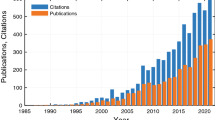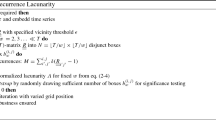Abstract
To perform probabilistic tsunami hazard assessment for subduction zone earthquakes, it is necessary to start with a catalog of possible future events along with the annual probability of occurrence, or a probability distribution of such events that can be easily sampled. For near-field events, the distribution of slip on the fault can have a significant effect on the resulting tsunami. We present an approach to defining a probability distribution based on subdividing the fault geometry into many subfaults and prescribing a desired covariance matrix relating slip on one subfault to slip on any other subfault. The eigenvalues and eigenvectors of this matrix are then used to define a Karhunen-Loève expansion for random slip patterns. This is similar to a spectral representation of random slip based on Fourier series but conforms to a general fault geometry. We show that only a few terms in this series are needed to represent the features of the slip distribution that are most important in tsunami generation, first with a simple one-dimensional example where slip varies only in the down-dip direction and then on a portion of the Cascadia Subduction Zone.













Similar content being viewed by others
Notes
We follow http://earthquake.usgs.gov/aboutus/docs/020204mag_policy.php and use \(M_w = \frac{2}{3} (\log _{10}(M_o) - 9.05)\) where the seismic moment \(M_o =\)length \(\times\) width\(\,\times\) (average slip)\(\,\times \,\)(rigidity) and set the rigidity to \(3.55\times 10^{10}\) N-m for this calculation.
References
Adams, L., LeVeque, R., & González, F. (2015). The pattern-method for incorporating tidal uncertainty into probabilistic tsunami hazard assessment (PTHA). Natural Hazards, 76, 19–39.
Anderson, J. G. (2015). The composite source model for broadband simulations of strong ground motions. Seismological Research Letters, 86(1), 68–74. doi:10.1785/0220140098.
Bastos, L. S., & O’Hagan, A. (2009). Diagnostics for Gaussian process emulators. Technometrics, 51(4), 425–438. doi:10.1198/TECH.2009.08019.
Benner, P., Gugercin, S., & Willcox, K. (2015). A survey of model reduction methods for parametric systems. SIAM Review, 57, 483531.
Chock, G.Y.K. (2015). The ASCE 7 tsunami loads and effects design standard. In N. Ingraffea, M. Libby (Eds.), Structures congress 2015 (pp. 1446–1456). American Society of Civil Engineers. doi: 10.1061/9780784479117.124.
Cliffe, K. A., Giles, M. B., Scheichl, R., & Teckentrup, A. L. (2011). Multilevel Monte Carlo methods and applications to elliptic PDEs with random coefficients. Computing and Visualization in Science, 14(1), 3–15. doi:10.1007/s00791-011-0160-x.
Dettmer, J., Hawkins, R., Cummins, P. R., Hossen, J., Sambridge, M., & Hino, R., et al. (2016). Tsunami source uncertainty estimation: The 2011 Japan tsunami. Journal of Geophysical Research: Solid Earth. doi:10.1002/2015JB012764.
Dick, J., Kuo, F. Y., & Sloan, I. H. (2013). High-dimensional integration: The quasi-Monte Carlo way. Acta Numerica, 22, 133–288. doi:10.1017/S0962492913000044.
Dreger, D. S., Beroza, G. C., Day, S. M., Goulet, C. A., Jordan, T. H., Spudich, P. A., et al. (2015). Validation of the SCEC broadband platform V14.3 Simulation methods using pseudospectral acceleration data. Seismological Research Letters, 86(1), 39–47. doi:10.1785/0220140118.
Frankel, A. (1991). High-frequency spectral falloff of earthquakes, fractal dimension of complex rupture, B value, and the scaling of strength on faults. Journal of Geophysical Research, 96, 6291–6302.
Geist, E. L. (2002). Complex earthquake rupture and local tsunamis. Journal of Geophysical Research, 107(B5), 2086. doi:10.1029/2000JB000139.
Geist, E. L., & Parsons, T. (2006). Probabilistic analysis of tsunami hazards. Natural Hazards, 37, 277–314.
Geist, E. L., Parsons, T., ten Brink, U. S., & Lee, H. J. (2009). In E. N. Bernard, A. R. Robinson (Eds.), The Sea (Vol. 15)., Tsunami probability. Harvard University Press.
Ghanem, R. (1999). The Nonlinear Gaussian spectrum of log-normal stochastic processes and variables. Journal of Applied Mechanics, 66(4), 964–973. doi:10.1115/1.2791806.
Ghanem, R. G., & Spanos, P. D. (1991). Stochastic finite elements: A spectral approach. New York: Springer.
Giles, M. B. (2008). Multilevel Monte Carlo path simulation. Operations Research, 56, 607–617. doi:10.1287/opre.1070.0496.
Goda, K., Mai, P. M., Yasuda, T., & Mori, N. (2014). Sensitivity of tsunami wave profiles and inundation simulations to earthquake slip and fault geometry for the 2011 Tohoku earthquake. Earth, Planets and Space, 66(1), 1–20. doi:10.1186/1880-5981-66-105.
Goda, K., Li, S., Mori, N., & Yasuda, T. (2015). Probabilistic tsunami damage assessment considering stochastic source models: Application to the 2011 Tohoku earthquake. Coastal Engineering Journal, 57(03), 1550,015. doi:10.1142/S0578563415500151.
González, F. I., LeVeque, R. J., Adams, L. M., Goldfinger, C., Priest, G. R., & Wang, K. (2014). Probabilistic tsunami hazard assessment (PTHA) for Crescent City, CA.
González, F. I., Geist, E. L., Jaffe, B., Knolu, U., Mofjeld, H., Synolakis, C. E., et al. (2009). Probabilistic tsunami hazard assessment at Seaside, Oregon, for near-and far-field seismic sources. Journal of Geophysical Research, 114(C11), 023.
Graves, R. W., & Pitarka, A. (2010). Broadband ground-motion simulation using a hybrid approach. Bulletin of the Seismological Society of America, 100(5A):2095–2123. doi:10.1785/0120100057. http://www.bssaonline.org/cgi/doi/10.1785/0120100057
Guatteri, M., Mai, P. M., Beroza, G. C., & Boatwright, J. (2003). Strong ground-motion prediction from stochastic-dynamic source models. Bulletin of the Seismological Society of America, 93(1), 301–313. doi:10.1785/0120020006.
Huang, S. P., Quek, S. T., & Phoon, K. K. (2001). Convergence study of the truncated Karhunen-Loève expansion for simulation of stochastic processes. International Journal for Numerical Methods in Engineering, 52(9), 1029–1043.
Jaimes, M. A., Reinoso, E., Ordaz, M., Huerta, B., Silva, R., Mendoza, E., et al. (2016). A new approach to probabilistic earthquake-induced tsunami risk assessment. Ocean and Coastal Management, 119, 68–75. doi:10.1016/j.ocecoaman.2015.10.007.
Karhunen, K. (1947). Über lineare Methoden in der Wahrscheinlichkeitsrechnung (vol 37). Universitat Helsinki
Lavallée, D., Liu, P., & Archuleta, R. J. (2006). Stochastic model of heterogeneity in earthquake slip spatial distributions. Geophysical Journal International, 165(2), 622–640. doi:10.1111/j.1365-246X.2006.02943.x.
LeVeque, R. J., Waagan, K., González, F. I., Rim, D., & Lin, G. (2016). Code to accompany this paper. https://github.com/rjleveque/KLslip-paper. doi:10.5281/zenodo.59720.
Li, J., Li, J., & Xiu, D. (2011). An efficient surrogate-based method for computing rare failure probability. Journal of Computational Physics, 230, 8683–8697. doi:10.1016/j.jcp.2011.08.008.
Loève, M. (1977). Probability theory (4th ed.). Berlin: Springer-Verlag.
Lorito, S., Selva, J., Basili, R., Romano, F., Tiberti, M. M., & Piatanesi, A. (2015). Probabilistic hazard for seismically induced tsunamis: Accuracy and feasibility of inundation maps. Geophysical Journal International, 200(1), 574–588. doi:10.1093/gji/ggu408.
Løvholt, F., Pedersen, G., Bazin, S., Kühn, D., Bredesen, R. E., & Harbitz, C. (2012). Stochastic analysis of tsunami runup due to heterogeneous coseismic slip and dispersion. Journal of Geophysical Research, 117(C3). doi:10.1029/2011JC007616.
Mai, P. M., & Beroza, G.C. (2002). A spatial random field model to characterize complexity in earthquake slip. Journal of Geophysical Research, 107, ESE10–1–ESE10–21
Melgar, D. (2016). MudPy software. http://www.github.com/dmelgarm/MudPy
Melgar, D., Allen, R. M., Riquelme, S., Geng, J., Bravo, F., Baez, J. C., et al. (2016a). Local tsunami warnings: Perspectives from recent large events. Geophysical Research Letters, 43(3), 2015GL067,100. doi:10.1002/2015GL067100.
Melgar, D., LeVeque, R. J., Dreger, D. S, & Allen, R.M. (2016b). Kinematic rupture scenarios and synthetic displacement data: An example application to the Cascadia Subduction Zone. Submitted
Nobile, F., Tempone, R., & Webster, C. G. (2008). A sparse grid stochastic collocation method for partial differential equations with random input data. SIAM Journal on Numerical Analysis, 46(5), 2309–2345. doi:10.1137/060663660.
Nosov, M. A., Bolshakova, A.V., & Kolesov, S.V. (2014). Displaced water volume, potential energy of initial elevation, and tsunami intensity: Analysis of recent tsunami events. Pure and Applied Geophysics, 171(12), 3515–3525. doi:10.1007/s00024-013-0730-6. http://link.springer.com/10.1007/s00024-013-0730-6
Okada, Y. (1985). Surface deformation due to shear and tensile faults in a half-space. Bulletin of the Seismological Society of America, 75, 1135–1154.
Olsson, A., & Sandberg, G. (2002). Latin hypercube sampling for stochastic finite element analysis. Journal of Engineering Mechanics, 128(1), 121–125. doi:10.1061/(ASCE)0733-9399(2002)128:1(121).
Peherstorfer, B., Cui, T., Marzouk, Y., & Willcox, K. (2016). Multifidelity importance sampling. Computer Methods in Applied Mechanics and Engineering, 300, 490–509. doi:10.1016/j.cma.2015.12.002.
Pollitz, F. F., McCrory, P.A., Wilson, D., Svarc, J., Puskas, C., & Smith, R.B. (2010). Viscoelastic-cycle model of interseismic deformation in the northwestern United States. Geophysical Journal International, 181, 665–696. http://doi.wiley.com/10.1111/j.1365-246X.2010.04546.x
Razafindrakoto, H. N. T., Mai, P. M., Genton, M. G., Zhang, L., & Thingbaijam, K. K. S. (2015). Quantifying variability in earthquake rupture models using multidimensional scaling: Application to the 2011 Tohoku earthquake. Geophysical Journal International, 202(1), 17–40. doi:10.1093/gji/ggv088.
Sarri, A., Guillas, S., & Dias, F. (2012). Statistical emulation of a tsunami model for sensitivity analysis and uncertainty quantification. Natural Hazards and Earth System Sciences, 12(6), 2003–2018. doi:10.5194/nhess-12-2003-2012.
Schwab, C., & Todor, R. A. (2006). Karhunen-Loève approximation of random fields by generalized fast multipole methods. Journal of Computational Physics, 217, 100–122.
Stein, S., Geller, R. J., & Liu, M. (2012). Why earthquake hazard maps often fail and what to do about it. Tectonophysics, 562–563, 1–25. doi:10.1016/j.tecto.2012.06.047.
USGS. (2010). USGS earthquake archive. http://earthquake.usgs.gov/earthquakes/eqinthenews/2010/us2010tfan/finite_fault.php
Van Trees, H. L., Bell, K. L., & Tian, Z. (2013). Detection estimation and modulation theory, part I, detection, estimation, and filtering theory (2nd ed.). New Jersey: Wiley.
Wang, K., & He, J. (2008). Effects of frictional behavior and geometry of subduction fault on coseismic seafloor deformation. Bulletin of the Seismological Society of America, 98, 571–579. doi:10.1785/0120070097.
Witter, R. C., Zhang, Y. J., Wang, K., Priest, G. R., Goldfinger, C., Stimely, L., et al. (2013). Simulated tsunami inundation for a range of Cascadia megathrust earthquake scenarios at Bandon, Oregon, USA. Geosphere, 9(6), 1783–1803. doi:10.1130/GES00899.1.
Zhang, L., Mai, P. M., Thingbaijam, K. K., Razafindrakoto, H. N., & Genton, M. G. (2015). Analysing earthquake slip models with the spatial prediction comparison test. Geophysical Journal International, 200(1), 185–198. doi:10.1093/gji/ggu383.
Acknowledgments
The initial phase of this work was performed when GL was employed at Pacific Northwest National Laboratory (PNNL) and KW was a postdoctoral fellow supported in part by PNNL and by the University of Washington (UW). This work was also supported in part by NSF Grants DMS-1216732 and EAR-1331412, funding from FEMA, and the Applied Mathematics Department of UW. The authors have benefitted from discussions with many applied mathematicians and geoscientists concerning the approach developed in this paper, including in particular Art Frankel, Finn Løvholt, Martin Mai, Siddhartha Mishra, Diego Melgar, and Hong Kie Thio. Numerous suggestions from the referees improved the quality of this paper.
Author information
Authors and Affiliations
Corresponding author
Rights and permissions
About this article
Cite this article
LeVeque, R.J., Waagan, K., González, F.I. et al. Generating Random Earthquake Events for Probabilistic Tsunami Hazard Assessment. Pure Appl. Geophys. 173, 3671–3692 (2016). https://doi.org/10.1007/s00024-016-1357-1
Received:
Revised:
Accepted:
Published:
Issue Date:
DOI: https://doi.org/10.1007/s00024-016-1357-1




